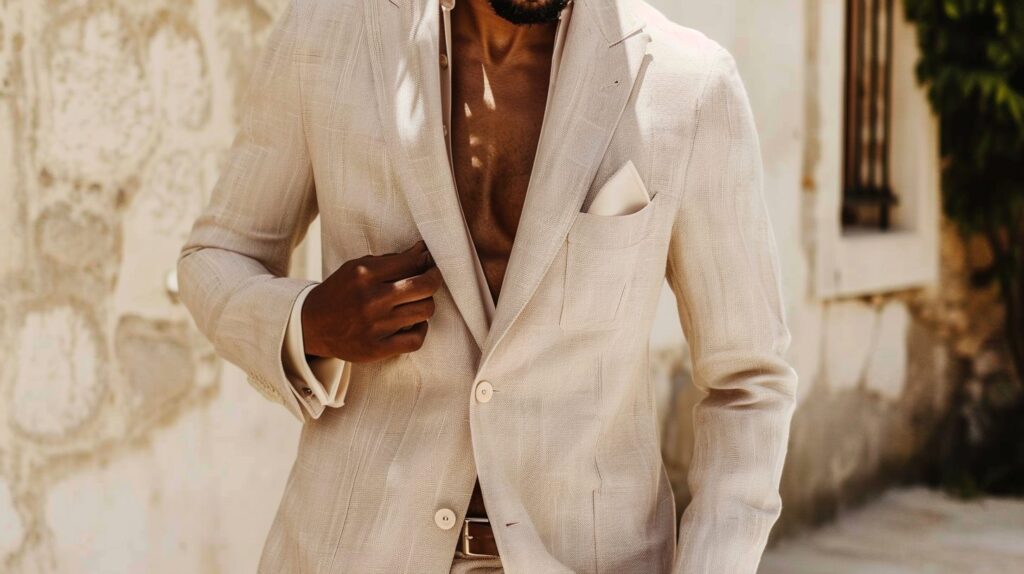Not every suit works for every season. Wearing wool in summer or linen in winter will leave you feeling uncomfortable and out of place. Seasonal suits fix this by matching fabrics, colors, and cuts to the time of year.
A seasonal suit keeps you both stylish and practical. Linen and cotton are light and breathable for summer, while wool, tweed, and flannel bring warmth in the colder months. Even colors shift, with light shades for spring and summer and darker tones for fall and winter.
Picture yourself in a crisp linen suit at a summer wedding or a deep charcoal wool suit at a winter event. The right choice makes you look sharp while staying comfortable. Seasonal fabrics help you dress with confidence no matter the occasion.
When buying your next suit, think about the season as much as the style. Choose breathable fabrics for warm days and heavier weaves for cold months. By planning with the seasons, your wardrobe will stay versatile and sharp all year.
Here’s What You’ll Learn:
- How seasonal suits work – Learn why fabrics and colors shift with the weather. This helps you dress right for comfort and formality year-round.
- Types of seasonal suits – From linen to wool, see which fabrics fit best in each season. You’ll know what to wear for heat, cold, and everything in between.
- Seasonal style choices – Understand how spring, summer, fall, and winter suits differ. This makes it easy to match your look to the season and setting.
- Fashion industry seasons – Find out how the fashion calendar affects when suits appear in stores. You’ll see why collections often arrive before the season starts.
- Shopping tips – Get simple advice for choosing the right seasonal suit. You’ll avoid common mistakes and build a wardrobe that always works.
What Is a Seasonal Suit?
A seasonal suit is a suit made from fabrics and styles designed to match the weather of a particular season. For example, lightweight materials like linen and cotton are used for summer suits to keep you cool, while heavier fabrics like wool and tweed are common for fall and winter to provide warmth. The colors and patterns may also shift with the season, with lighter shades for warmer months and darker tones for colder ones.
Types of Seasonal Suits
Linen Suits (Summer)

Linen suits are light, breathable, and perfect for staying cool on hot days. They wrinkle more easily but give a relaxed and stylish summer look.
Cotton Suits (Summer and Spring)

Cotton suits are comfortable, versatile, and less formal than wool. They work well for warm-weather offices, casual weddings, and daytime events.
Wool Suits (Winter and Fall)

Wool suits are warm, durable, and classic. They come in many weights and styles, making them a reliable choice for colder months and formal settings.
Tweed Suits (Winter)

Tweed suits are thick, textured, and stylish. They’re perfect for very cold weather and add a traditional, vintage charm to your look.
Flannel Suits (Fall and Winter)

Flannel suits are soft, warm, and cozy while still looking sharp. They are great for business wear and evening occasions in chilly weather.
Lightweight Wool Suits (Spring)

Lightweight wool suits offer comfort in mild weather, balancing coolness and warmth. They are versatile and can easily transition between professional and social settings.
Seasonal Suit Styles: Choosing the Right Suit for Every Season
🌸 Spring
Go for lightweight wool or cotton suits. Soft colors like light gray, beige, or pastels match the season’s freshness. Perfect for outdoor events and mild workdays.
☀️ Summer
Linen and seersucker keep you cool. Light shades such as cream, beige, or pale blue feel breezy. Skip heavy fabrics, as they trap heat.
🍂 Fall
Choose wool blends or flannel for comfort. Earth tones like brown, burgundy, and olive fit the autumn vibe. These suits keep you warm while looking sharp.
❄️ Winter
Tweed, wool, and flannel are best for cold days. Dark colors like navy, charcoal, or black look refined. Add layers like vests or coats for extra warmth.
The Fashion Seasons Explained
Fashion is not only about the weather but also about industry timing. Designers, brands, and seasonal stores follow a fashion calendar that sets when clothes are shown and sold.
1. Why Are There Seasons in the Fashion Industry?
Fashion seasons allow designers and brands to prepare collections ahead of time. This system helps:
- Stores know when to release new clothes.
- Designers show trends early.
- Buyers plan for upcoming months.
2. What Are the Seasons in the Fashion Industry? How Many Fashion Seasons Are There Per Calendar Year?
Traditionally, there are two main fashion seasons:
- Spring/Summer (SS)
- Fall/Winter (FW)
In recent years, many brands also add:
- Resort/Cruise collections
- Pre-Fall collections
So depending on the brand, there can be 2 to 4 collections each year. This is why people often ask, “How many suits seasons are there?” The answer depends on the fashion calendar.
3. What About the Timing? When Are Fashion Collections Actually Shown and Sold?
Fashion collections are usually shown months before the actual season:
- Spring/Summer collections: Shown in September of the previous year.
- Fall/Winter collections: Shown in February of the same year.
This means clothes are often designed long before you see them in stores.
4. The Problem with the Fashion Calendar
The biggest problem is that fashion seasons do not match weather seasons. For example:
- Winter suits may arrive in stores when it’s still warm.
- Summer suits may be sold before the hot months begin.
This often confuses shoppers, which is why many seasonal outfitters try to balance fashion timing with real weather.
Suits and Seasonal Shopping
When shopping for seasonal suits, here are tips to keep in mind:
- Check suits seasons release dates: Stores often launch seasonal collections early.
- Read suits seasons summary guides: These give you a quick view of what’s trending.
- Visit seasonal stores: They focus on current-season fabrics and styles.
- Look for clothes for seasons: Make sure the fabric matches the weather, not just fashion.
- Ask yourself: What season does suits get bad? Usually when you wear the wrong fabric—like wool in summer or linen in winter.
Final Thoughts
Seasonal suits make dressing easier, sharper, and more comfortable. By understanding how fashion seasons work and how many suits seasons there are, you can plan your wardrobe better. Whether it’s a suit for winter season warmth or a linen suit for summer heat, the key is matching fabric, color, and style to the time of year.



